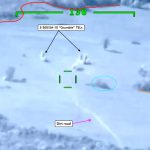The Polish government has signed a contract with Lockheed Martin to buy 32 F-35A stealth multirole fighter jets for the Polish Air Force, on January 31, 2020. The contract is estimated to be worth $4.6 billion, making it the biggest military purchase in the country’s history. The first F-35As are expected to arrive in Poland in 2026.
The groundbreaking purchase makes Poland the first Central and Eastern European country country to acquire the fifth generation aircraft. Warsaw joins the exclusive club of current or future F-35 operators, that includes six NATO members (United States, the United Kingdom, Italy, Norway, the Netherlands, Belgium and Denmark), Japan, Australia, Singapore and the Republic of Korea.
DĘBLIN | Prezydent RP bierze udział w podpisaniu umowy na zakup samolotów F-35 https://t.co/5l6UGtPfv7
— Kancelaria Prezydenta (@prezydentpl) January 31, 2020
REPLACING OLD SOVIET AIRCRAFT
The American defense contractor will deliver the latest configuration (Block 4) of the F-35’s Conventional Take-Off and Landing (CTOL) version. The Block 4 features an expanded missile capacity, from four to six internally carried missiles, improved sensors and data-link, and advanced computing power. The Polish Air Force (PoAF) will use the F-35s to replace the Soviet-era legacy Su-22 fighter-bombers (NATO Reporting name: “Fitter”) and MiG-29 air superiority jets (“Fulcrum), and will serve alongside its existing fleet of 48 F-16s.
ENHANCING POLISH AIR FORCE CAPABILITIES
With the F-35 in service, the PoAF will posses a top-of-the-line air defense capability and striking platform. Poland will enjoy unmatched interoperability in joint force and Coalition operations. In addition to national air policing, the F-35A will enable Poland to conduct Destruction/ Suppression of Enemy Air Defenses (D/SEAD), Offensive Counter Air (OCA) and to prosecute targets defended by enemy anti-access/ area-denial (A2/AD) “bubbles.”
STEALTH
The F-35 is known for its low-observability (or stealth), sensor fusion, increased situational awareness and integrated electronic warfare system, but also for its production delays and constant software patches. Born from the Joint Strike Fighter (JSF) program, the F-35 was designed as a jack-of-all-trade platform to satisfy the operational requirements of the three major U.S. military branches. As the Navy, Air Force and Marine Corps have different needs and operational doctrines, the JSF’s initial requirements mutated in the compromise and more economical formula we have today. However, the one element that remained universally embraced was stealth.
Contrary to widespread misperception, stealth is not invisibility. Rather, stealth gives the F-35 the ability to elude or greatly complicate an enemy’s ability to find and destroy an aircraft using a combination of tactics and technology. In general, stealth is the ability to evade detection by radar, infrared sensors or emission interception. Stealth provides greater survivability and access, allowing aircraft to operate in contested A2/AD environments, that legacy fighters simply cannot penetrate or evade.
An integrated airframe design, advanced radar-absorbing materials, low-probability of intercept sensors and other features maximize the F-35’s stealth features. This allows the F-35 to defeat upper band radars (X- and Ku-bands) that are used by air defense systems for SAM engagement control. The aircraft performs less effective against early-warning and acquisition radars operating in the lower bands (UHV/ VHF), however these sensors are unable to provide engagement guidance , and can only “paint” a vague picture of threat.
REAL TEST AFTER 2026
With the F-35 purchase, Poland sets an example for the other NATO militaries that are still struggling to transition from the defunct Warsaw Pact model. However, the real test begins after 2026 when the PoAF will have to undertake the exhausting task of absorbing the F-35 fleet into operational use and keep its combat readiness rate high. Another Herculean challenge will be to provide constant maintenance to the “needy” platform, in the form of software patches, logistical support infrastructure, weapons integration, LO coating maintenance and other aspects.
- Russia Bombs Maternity Ward & Children’s Hospital in Mariupol As Part of Siege - 10 March 2022
- T-Intell’s OSINT Training Marks One Year Anniversary - 18 November 2021
- Russian Pipe-Layer Resumes Work on Nord Stream 2 - 25 January 2021





